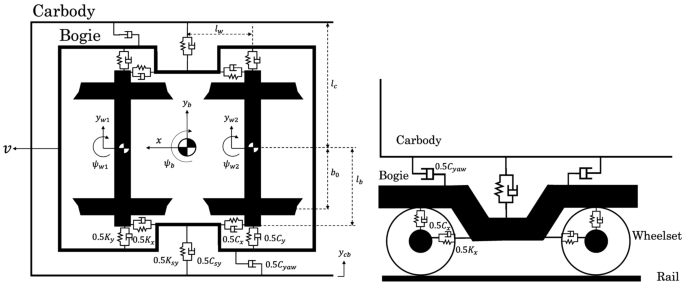Estimation of wheelset equivalent conicity using the dual extended Kalman filter
IF 2.4
2区 工程技术
Q2 MECHANICS
引用次数: 0
Abstract
Abstract This paper presents the implementation of the dual extended Kalman filter (DEKF) to estimate wheelset equivalent conicity, an accurate understanding of which can facilitate the implementation of an effective model-based estimator. The estimator is developed to identify the wheelset equivalent conicity of high-speed railway vehicles while negotiating a curve. The designed DEKF estimator employs two discrete-time extended Kalman filters combining state and parameter estimators in parallel. This estimator uses easily available measurements from acceleration sensors measuring at axle boxes and a rate gyroscope measuring bogie frame yaw velocity. Two tests, including linearized and actual wheel-rail geometry, are carried out at a speed of 250 km/h with stochastic and deterministic track features using multibody simulations, SIMPACK. The results with acceptable estimation errors for both track conditions indicate adequate performance and reliability of the designed DEKF estimator. They demonstrate the feasibility of utilizing this DEKF method in rail vehicle applications as the knowledge of time-varying parameters is not only important in achieving an effective estimator for vehicle control but also useful for vehicle condition monitoring.

利用对偶扩展卡尔曼滤波估计轮对等效圆锥度
摘要本文提出了双扩展卡尔曼滤波(dual extended Kalman filter, DEKF)估计轮对等效圆锥度的方法,准确理解该方法有助于实现有效的基于模型的估计器。针对高速铁路车辆过弯时轮对等效锥度的辨识问题,开发了该估计器。所设计的DEKF估计器采用两个离散扩展卡尔曼滤波器,将状态估计器和参数估计器并行结合。该估计器使用易于获得的测量从加速度传感器测量轴箱和速率陀螺仪测量转向架框架偏航速度。两项测试,包括线性化和实际轮轨几何,在250公里/小时的速度下进行,使用多体模拟SIMPACK进行随机和确定性轨道特征。结果表明,所设计的DEKF估计器具有良好的性能和可靠性。他们证明了在轨道车辆应用中利用这种DEKF方法的可行性,因为时变参数的知识不仅对实现车辆控制的有效估计很重要,而且对车辆状态监测也很有用。
本文章由计算机程序翻译,如有差异,请以英文原文为准。
求助全文
约1分钟内获得全文
求助全文
来源期刊
CiteScore
6.00
自引率
17.60%
发文量
46
审稿时长
12 months
期刊介绍:
The journal Multibody System Dynamics treats theoretical and computational methods in rigid and flexible multibody systems, their application, and the experimental procedures used to validate the theoretical foundations.
The research reported addresses computational and experimental aspects and their application to classical and emerging fields in science and technology. Both development and application aspects of multibody dynamics are relevant, in particular in the fields of control, optimization, real-time simulation, parallel computation, workspace and path planning, reliability, and durability. The journal also publishes articles covering application fields such as vehicle dynamics, aerospace technology, robotics and mechatronics, machine dynamics, crashworthiness, biomechanics, artificial intelligence, and system identification if they involve or contribute to the field of Multibody System Dynamics.

 求助内容:
求助内容: 应助结果提醒方式:
应助结果提醒方式:


